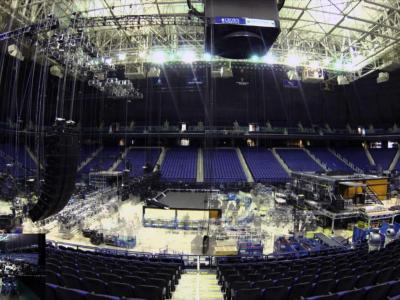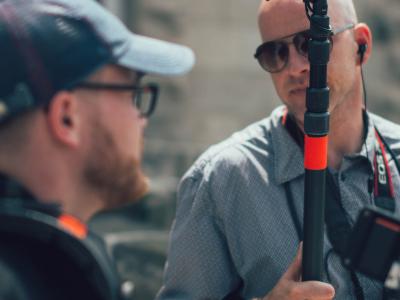Every seasoned performer knows the importance of an excellent sound engineer. No matter what the genre of the music, if the sound engineer doesn't build a mix that sounds good, the creativity, passion, and brilliance of the performance will be tarnished. A sound engineer who knows how to create a mix that sounds great and can build and deploy a high-quality sound system is highly coveted throughout the music industry.
This course explores the acoustical, musical, and technical aspects of the live performance, in order to learn how to present the best possible sound to the audience. You will study, evaluate, and compare several different live and studio recordings in order to establish a point of reference for your own mix choices. The course emphasizes instrument sounds, microphones, equalization, and dynamics processing. These tools are presented in a manner that places a high value on the creative and technical influences they impose on the individual sounds, as well as the control they can offer for multiple sounds, channels, and tracks.
The goal of the course is to enable you to build your own mixes and use what you've learned to conform to a high standard for sonic quality, blend, and authenticity. When properly equipped with the tools, techniques, and insights needed to build an excellent mix, you will be the musicians' closest and most trusted ally.
By the end of the course, you will be able to:
- Identify important considerations regarding music, including the identification of the types of sounds that work well in a professional mix
- Apply logistical and managerial techniques to help manage equipment, setup teams, and road crews
- Achieve excellent vocal sounds for various styles, genres, and acoustical environments
- Use microphone technique, equalization, effects, and dynamics processing to build excellent piano, acoustic guitar, electric guitar, keyboard, bass guitar, drums, and percussion sounds so they function well together
- Build a high-quality mix that is appropriate for a wide variety of age groups, stylistic preferences, and acoustical environments
- Identify special considerations for recording the live show
Syllabus
Lesson 1: The Sound Operator and Musical Considerations
- Qualifications of a Sound Operator
- Duties of the Sound Operator
- Preventing Catastrophe
- The Musical Function of the Band Members
- Song Form and the Contemporary Pop Song
- Arrangement Format
- Song Structure
- Common Song Form Sections
- Common ABC Song Forms
Lesson 2: Sound Theory and Acoustic Considerations
- Your Sound System
- Sound Theory
- Waves
- Amplitude
- Phase
- Frequency and Wavelength
- Velocity
- Harmonic Content
- Envelope
- Acoustics
- Hearing
- Documenting Your Sound System
- Analyzing the Acoustic Space
- Acoustic Treatment Options
Lesson 3: Interconnect and Mixer Basics
- Interconnect Basics
- Introduction to The Mixer
- Mixer Basics
- Gain Structure
- Operating Level
- Connecting a Recorder to Your Mixer
Lesson 4: Microphones
- Microphone Design
- Directional Characteristics
- Additional Mic Characteristics and Applications
- Wireless Systems
- Lavaliere and Headset Microphones
- Keep it Real
Lesson 5: Equalization and Dynamics
- Equalizers: Building Puzzle Pieces
- EQ Types
- Filters
- Dynamics
- Using Effects
- Delay Effects
- Parameters
Lesson 6: Speakers, Amplifiers, and System Processors
- Loud Speakers
- Speaker Cable
- Amplifiers
- System Processors
- Basic Analysis: Setting the System Up
- White and Pink Noise
- Real-Time Analyzer (RTA)
- Ringing Out the System
- Voicing the System
- Leakage
- Wedge Monitors
- In-Ear Monitors
Lesson 7: How to Get Great Drum and Percussion Sounds
- Getting the Acoustic Drums to Sound Good
- Miking the Drums
- Processors for Drums
- Blending the Drums
- Isolation
- Electronic Drums
Lesson 8: Getting Great Acoustic, Electric, and Bass Guitar Sounds
- Acoustic Guitar
- Running Direct
- Equalization
- Miking the Acoustic Guitar
- Building the Electric Guitar Sound
- Running Direct vs. Miking the Speaker Cabinet
- The Bass Guitar
- Acquiring the Bass Sound
Lesson 9: Getting Great Vocal Sounds
- Choosing a Vocal Mic
- Mic Technique
- Song Leaders at Church
- Vocal Miking
- Lead Vocalist
- Backing Vocals
- Choir
- Covering the Group
- Using Processing in Your Vocal Mix
- Blending Vocals in the Mix
Lesson 10: Keyboard Sounds, Sound Check, and Setting Up the Mix
- Keyboard Sounds
- Electric Pianos and Synths
- Running an Efficient Setup and Sound Check
- Sound Check Checklist
- Setup Routine
- Floor Monitor Level
- In-Ear Monitors
- Stage Map and Channel List
- Front of House System Functionality
- Considerations when using a Digital Mixer
- Creating a Mix Plan
- Putting the Pieces Together
- Volume Issues
Lesson 11: Putting it All Together
- Fundamentals of Building Great Sounds for the Core Instruments
- Establishing the Foundation
- Using Dynamics and Effects Appropriately
- Establishing a Baseline Volume and Keeping It There
Lesson 12: Recording the Gig and More Mixing Techniques
- Creating a Mix
- Blending
- Dynamics
- Highlighting Certain Ingredients
- Keeping the Focal Point
- The Board Recording
- Setting Up a Multitrack Recorder to Record the Music Team
Requirements
Prerequisites and Course-Specific Requirements
Prerequisite Courses, Knowledge, and/or Skills
Completion of one of the following courses Pro Tools 101, Pro Tools 110, Producing Music with Logic, Producing Music with Reason, Producing Music with Cubase, Ableton Live Fundamentals, or equivalent knowledge and experience is required.
You should be actively involved with a performance group of some type, whether a club band, church music team, or other performance entity. You must be proficient with basic digital audio workstation (DAW) functions and must be able to download, upload, receive, and send audio files. You must also have an audio connection from the main FOH mixer in a performance venue to a CD recorder, DAW, or some other audio recording device, and the ability to save the audio data in a format suitable for email or uploading.
Textbook(s)
- The Ultimate Live Sound Operator's Handbook (3rd Edition) by Bill Gibson (Hal Leonard, 2020)
- Live Sound Reinforcement by Scott Hunter Stark (Artistpro, 1996)
Media and Subscriptions
- One of the following:
- A subscription to a music streaming service such as Apple Music, TIDAL, or Spotify
- CD player and the following CDs:
- Dave Mathews Band - Live at Piedmont Park
- Death Cab for Cutie - Live from Las Vegas at the Palms
- Death Cab for Cutie - Plans
- Eric Clapton - Complete Clapton
- Harry Belfonte - Harry Belefonte: At Carnegie Hall
- Norah Jones - Come Away with Me
- Various Artists - Grammy Nominees 2003
- Pink Floyd - Dark Side of the Moon
- Steely Dan - Aja
- U2 - The Joshua Tree
- U2 - Live from Paris
Recording
- Students are required to submit MP3 recordings of live instruments and/or vocals for various assignments. It’s preferable for you to have access to musicians for practice; ideally you are a sound operator for a performance group. If you don't have access to a performance group, an alternate activity will be provided.
Software
- Digital Audio Workstation (DAW). Free options, such as GarageBand (Mac) or Cakewalk by BandLab (PC), are acceptable.
- Spreadsheet software, such as Microsoft Excel, Google Sheets (free), Apple Numbers, Apache Open Office (free), etc.
Hardware
- Audio interface with at least two inputs and necessary cables, to capture a multitrack recording of the main stereo FOH (front of house) mix
- Note: Alternatively, students can use a digital mixer instead of an audio interface, but will need to be able to export their recorded audio from the mixer to their DAW.
- Closed back, over-ear studio headphones such as Sony MDR-7506 or better
- Decibel meter with the ability to measure A- and C-weighted decibel scales
- Note: A smartphone app with A- and C-weighted settings is acceptable.
- Recommended: Dynamic XLR microphone
- Recommended: Ribbon XLR microphone
- Recommended: Condenser XLR microphone
- Recommended: Cable tester, such as Behringer CT 100
Student Deals
After enrolling, be sure to check out our Student Deals page for various offers on software, hardware, and more. Please contact support@online.berklee.edu with any questions.
General Course Requirements
Below are the minimum requirements to access the course environment and participate in Live Classes. Please make sure to also check the Prerequisites and Course-Specific Requirements section above, and ensure your computer meets or exceeds the minimum system requirements for all software needed for your course.
Mac Users
PC Users
All Users
- Latest version of Google Chrome
- Zoom meeting software
- Webcam
- Speakers or headphones
- External or internal microphone
- Broadband Internet connection
Instructors
Author & Instructor
Bill Gibson is president of Northwest Music and Recording, Inc. and has spent the last 35 years writing, recording, producing, and teaching music. As an audio professional and active sound engineer, Bill has developed unique insights into the techniques and procedures that produce extremely high quality audio, both in the recording studio and in live performances. He is the author of more than 35 books and videos, and his writings are acclaimed for their straightforward and understandable explanations of audio concepts and applications.
As an author, developmental editor, and communications and training specialist for Hal Leonard Corporation, Gibson has written and produced a wide range of instructional content under his own name (The Hal Leonard Recording Method, The Ultimate Live Sound Operator’s Handbook, and many more) and alongside some of the music industry’s most iconic professionals including: Quincy Jones (Q on Producing), Bruce Swedien (The Bruce Swedien Recording Method), Dave Pensado (The Pensado Papers), Sylvia Massy (Recording Unhinged), Alan Parsons (The Art and Science of Recording), Al Schmitt (Al Schmitt On the Record), Ed Cherney (in production), and many more.
As a two-term GRAMMY National Trustee, a member of the National Advisory Committee for the Producers & Engineers Wing, the Planning & Governance Committee, and as a Governor for the Pacific Northwest Chapter of The Recording Academy, Gibson advocates for the benefit of music producers, technicians, and performers locally, regionally, nationally, and internationally. He also authored “Recommendations for High-Resolution Music Production” for the Producers & Engineers Wing along with committee members Leslie Ann Jones, Chuck Ainlay, Bob Ludwig, Rick Plushner, and Phil Wagner. Read Less
What's Next?
When taken for credit, Live Sound: Mixing and Recording can be applied towards the completion of these related programs:
Related Certificate Programs
Related Degree Majors
Questions?
Contact our Academic Advisors by phone at 1-866-BERKLEE (U.S.), 1-617-747-2146 (INT'L), or by email at advisors@online.berklee.edu.







